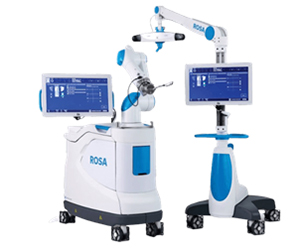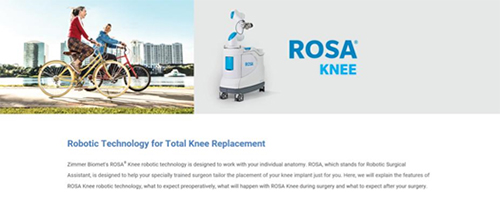Our Technology
Rosa Robotic Knee Surgery
The ROSA Knee System supports Surgeons in performing total knee arthroplasty, including the following features:
- Assistance with bone resections,
- Assessment of soft tissues to facilitate implant positioning intra-operatively.
The robotic approach is performed to relieve pain caused by joint degeneration due to osteoarthritis. It is performed using robotic-arm technology, which allows the surgeon to perform the procedure precisely.
What is the Rosa Robotic System

The ROSA offers a combination of cutting-edge technologies, including
- Computer navigation
- Soft tissue balancing
- 3D modelling
- Robotics
"Joint replacement surgery is a very successful operation, as shown by the results in the National Joint Registry. As Orthopaedic Surgeons, we are always trying to improve patient outcomes and the survivorship of implants.
Robotic technologies have been developed to improve surgical precision, component alignment and soft tissue balance with the expectation that this will improve patient outcomes.
While the early results of robotic-assisted surgery are encouraging, it will take many years to see if the potential benefits of improved alignment and balance are realised.
I am excited that we now have access to this technology and look forward to realising its potential."
How ROSA Knee Robot Works
The ROSA Knee robot is a surgical assistant designed to adapt to the required workflow and support a wide range of surgical philosophies.
The ROSA technology allows Dr Hocking to conduct a “virtual knee replacement” with predictable outcomes before the surgery. This enables improved soft tissue balancing.
Accurate implant placement is also achieved as the precision planning allows the knee implant to be secured exactly over the prepared portion of the knee joint.
The ROSA Knee System allows more accurate pre-operative planning and preparation of the implants; which will precisely match your anatomy.
Robotic Knee Technology
Getting a precise knee implant fit is essential to your comfort and overall experience following knee replacement surgery.
ROSA Knee robotic technology uses data collected before and during surgery to inform your surgeon of many details related to your unique anatomy that may affect your implant fit. Using this data to make more informed decisions, your surgeon can plan for and carry out a personalised surgery based on your individual needs.
Before surgery
Your preoperative experience will be like that of most total knee patients. But, unlike traditional knee replacement methods, with ROSA Knee robotic technology, a series of x-rays may be used to create a three-dimensional (3D) model of your knee anatomy. This 3D model will enable the surgeon to plan many specifics of your knee replacement before surgery.
During surgery
The surgical procedure using ROSA Knee robotic technology is similar to traditional total knee replacement but with a robotic assistant. Your surgeon has been trained to use ROSA Knee to personalise the surgical approach for your unique anatomy. It’s important to understand that the robot does not operate independently. That means it does not move unless your surgeon prompts it to. Your surgeon is still in the operating room the entire time and making all the decisions throughout your surgery.
During your procedure, ROSA Knee utilises a camera and optical trackers attached to your leg to know precisely where your knee is in space. Think of it like a very detailed global positioning system (GPS) you might use in your car. If your leg moves even a fraction of an inch, the robot can tell and adjusts accordingly. This helps ensure that the plan your surgeon put into place is executed as intended. Throughout your surgery, ROSA Knee provides your surgeon with data about your knee. This information, combined with your surgeon’s skill, helps them know how to position your implant based on your unique anatomy.
After surgery
Following surgery, you will be hospitalised based upon the recovery plan your surgeon decides is best for you. This hospitalisation may range from one to three days. Recovery time varies, but most people should be able to drive after two weeks, garden after three to four weeks, and golf after six to eight weeks. Your surgeon will tell you when and what activities you can return to and what activities to avoid.
Complications
While uncommon, complications can occur during and after surgery. Some complications include but are not limited to infection, blood clots, implant breakage, malalignment and premature wear, which can require additional surgery. Although implant surgery is highly successful in most cases, some patients still experience stiffness and pain. No implant will last forever, and factors such as your post-surgery activities and weight can affect longevity. Be sure to discuss these and other risks with your surgeon.
There are many things that your surgeon may do to minimise the potential for complications. Your surgeon may have you see a medical physician before surgery to obtain tests. You may also need up-to-date dental work and be shown how to prepare your home to avoid falls.
Summary
The decision to have surgery is sometimes difficult. We hope this information has helped you understand the ROSA Knee robotic technology. This information is not intended to replace the experience and counsel of your orthopaedic surgeon. If you have any further questions, please speak with your orthopaedic surgeon.

